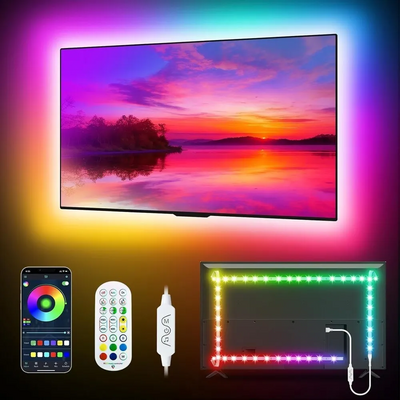
Unbranded LED TV backlighting
| Brand | Unbranded |
| Model | LED TV backlighting |
| Released Year | - |
| Type | TV |
| Screen Size | 65 in |
| Display Technology | LED |
| Status | Active |
Quick view
Overview
LED TV backlighting refers to the use of light-emitting diodes to illuminate liquid crystal displays (LCDs) in televisions. Unlike traditional cold cathode fluorescent lamps (CCFL), LED backlighting offers superior brightness, contrast, and energy efficiency. The LEDs can be implemented either as edge-lit or full-array backlights, allowing for different performance characteristics. Edge-lit LED TVs position LEDs along the edges and use light guides to distribute light across the panel, while full-array LED backlighting places LEDs directly behind the screen for better local dimming control. This technology supports thinner TV designs and improves color reproduction and dynamic range. Additionally, LED backlighting contributes to lower power consumption and longer panel lifespan compared to CCFL backlighting.
Specifications
| Light Color | Multicolor |
| Number Of Light Sources | 150 |
| Number Of Items | 1 |
| Display Technology | LED |
| Unit Count | 1.0 Count |
| Power Source | Ac/dc |
| Occasion | Christmas |
| Controller Type | Remote Control |
| Wattage | 5 Watts |
| Wireless Communication Technology | Bluetooth |
| UPC | Does not apply |
| Year Manufactured | LED TV backlighting |
| Batteries | 1 Cr2 Batteries Required. |
| Indoor/outdoor Usage | Indoor |
| Connectivity Protocol | Bluetooth |
| Voltage | 5 Volts |
| Style | Modern |
| Features | Remote Control Included, RGB Color Changing, Music Sync, Dynamic Effects, Bluetooth Connectivity, 3-Way Control, Easy to Install, Timing Mode |
| Special Feature | Corded |
| Indoor Outdoor Usage | Indoor |
| Screen Size | 65 in |
| Package Dimensions | 6.46 X 5.16 X 0.63 Inches; 4.16 Ounces |
| Color | Dream Colored |
| Control Method | App, Remote |
| Number Of Batteries | 1 Cr2 Batteries Required. |
| Audio/Video Inputs | USB |
| Smart TV Features | Not Supported |
| Maximum Resolution | LED TV backlighting |
| Water Resistance Level | Not Water Resistant |
| Product Style | Modern |
| Model | LED TV backlighting |
| Additional Features | Corded |
| Theme | Party |
| Light Source Type | Led |
| Connectivity Technology | Bluetooth |
| Backlight Type | LED (Light Emitting Diode) |
| Implementation | Edge-lit or Full-array with Local Dimming |
| Power Consumption | Lower than CCFL backlighting, varies with model |
| Lifespan | Typically 30,000 to 100,000 hours |
| Color Enhancement | Improved color accuracy and brightness uniformity |
| HDR Support | Enhanced with full-array local dimming technology |
Images
Key Advantages
LED backlighting enables higher contrast ratios and better black levels due to precise local dimming capabilities. It significantly improves energy efficiency compared to traditional CCFL backlights, reducing electricity consumption. LEDs have a longer operational life, reducing maintenance and replacement costs. The technology allows for slimmer and lighter TV panel designs, enhancing aesthetic appeal and installation flexibility. LED backlighting provides better color accuracy and uniform brightness distribution across the screen. Additionally, the ability to implement dynamic backlight control enhances HDR performance in compatible displays.
Limitations
LED TV backlighting may suffer from issues such as uneven brightness in edge-lit models due to the light guide limitations. Full-array backlight systems can increase manufacturing costs and TV weight compared to edge-lit models. Local dimming can sometimes create halo or blooming effects around bright objects on dark backgrounds. The quality and performance vary significantly depending on the LED placement and dimming zones implemented by the manufacturer. Some LED backlights struggle with uniformity and color consistency over time. Lastly, LED backlighting is limited in achieving perfect black levels compared to OLED technology.
FAQ
What is LED backlighting in TVs?
LED backlighting is a technology that uses light-emitting diodes to illuminate the LCD panel in a television, improving brightness, contrast, and energy efficiency.
How does LED backlighting differ from CCFL backlighting?
LED backlighting uses LEDs as the light source, whereas CCFL uses cold cathode fluorescent lamps; LEDs offer better energy efficiency, longer life, and improved picture quality.
What are the types of LED backlighting in TVs?
The main types include edge-lit LED, where LEDs are placed on the panel edges, and full-array LED, with LEDs evenly distributed behind the display.
Does LED backlighting affect TV thickness?
Yes, LED backlighting allows for thinner and lighter TV designs compared to CCFL-based models.
Can LED backlighting improve HDR performance?
Yes, especially with full-array local dimming, LED backlighting can enhance HDR by providing better contrast and brightness control.
Are there any drawbacks to LED backlighting?
Some drawbacks include potential uneven brightness in edge-lit models and halo effects in full-array local dimming systems.
Is LED backlighting technology still used in modern TVs?
Yes, LED backlighting remains widely used in LCD TVs today, though newer technologies like OLED are also popular for their superior black levels.
Disclaimer
The content on is provided for general informational purposes only. We do not guarantee the accuracy, completeness, or reliability of any information, specifications, or visuals presented on the site.
is not responsible for any content, images, or data uploaded or shared by users. Users are solely responsible for the content they submit.
We may include links to third-party websites for convenience. We do not endorse or take responsibility for the content or policies of any external sites.
Use of the site is at your own risk. Always verify critical information independently before making decisions based on content from this website.







